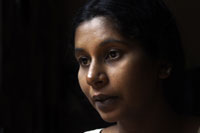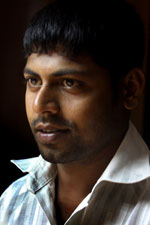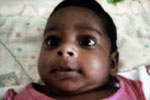They have buried two of their baby boys within the short span of two agonizing years and as they look out of their window and see the tiny graves in their garden at Dippitigala, Lellopitiya in Ratnapura, fear and uncertainty grip them.
 Will the baby boy that 26-year-old K.B.N. Damayanthi is carrying be doomed to suffer the same fate? The joyous event of the birth of a son, their third, is overshadowed by the acute fear of death. As the day of the baby’s birth draws near in early July, both Damayanthi and husband K.W. Neil Anura Shantha, 29, long to hold him close but will it only be for just a few months……….a fleeting dream of baby gurgles and impish smiles ending in a nightmare of death. Will the baby boy that 26-year-old K.B.N. Damayanthi is carrying be doomed to suffer the same fate? The joyous event of the birth of a son, their third, is overshadowed by the acute fear of death. As the day of the baby’s birth draws near in early July, both Damayanthi and husband K.W. Neil Anura Shantha, 29, long to hold him close but will it only be for just a few months……….a fleeting dream of baby gurgles and impish smiles ending in a nightmare of death.
It was with much hope that Damayanthi married her girlhood sweetheart “Neil Aiyya” in 2003, setting up a cosy home at Dippitigala. Life was tough but both worked very hard – she to keep the home neat and tidy and he to keep the home fires burning, toiling each day improve his “metta” (mattress) business.
 Fulfilment came when Damayanthi gave birth to a bouncing baby boy, Vishwa Dinura Devmeth, on October 3, 2005. “There was no weakness in the baby,” says Damayanthi hardly able to keep the body-wracking sobs away, while Neil watches in mute agony. Kisima durwala kamak thibbe ne, says Neil, explaining that although there was no weakness in the baby, when he was about four months old he suddenly developed a breathing problem. As he was taking quick, shallow breaths they rushed him to the Ratnapura Hospital. Fulfilment came when Damayanthi gave birth to a bouncing baby boy, Vishwa Dinura Devmeth, on October 3, 2005. “There was no weakness in the baby,” says Damayanthi hardly able to keep the body-wracking sobs away, while Neil watches in mute agony. Kisima durwala kamak thibbe ne, says Neil, explaining that although there was no weakness in the baby, when he was about four months old he suddenly developed a breathing problem. As he was taking quick, shallow breaths they rushed him to the Ratnapura Hospital.
The baby was irritable and when Damayanthi attempted to feed him, hit out at her with his tiny fist. She hugged him close but realized “something” was happening. He was then rushed to the Intensive Care Unit but died on February 25, 2006, with the parents being told that there was an infection in the lungs.
“We hadn’t even taken a photograph of the baby,” sighs Damayanthi as the tears flow.
But they do have a photo of their second son, Dinura Vinod, which Neil had taken from their phone soon after Damayanthi delivered him through a caesarian section on December 17, 2007. Fearing for their baby, they brought him to the Ragama Teaching Hospital when he was two weeks old, because they remembered that Damayanthi’s Punchi (mother’s younger sister) had similar experiences.

Little Dinura: A short life of four months |
It was after several tests at Ragama Hospital that they were gently told by Consultant Paediatrician Dr. Vasantha Karunasekara that there was a “jana prashnayak” (genetic problem) where “puthala nethiwenava” (male children were lost). “Kelle me thalassaemia wage, jana wala prashnayak,” the doctor told Damayanthi.
Tests had been done on the second son of Damayanthi’s Punchi and that is how the rare Severe Combined Immuno-deficiency Syndrome had been detected. It was a disease that could not be cured. (See box)
The doctor and staff were extremely caring and when weekly they brought their baby to the clinic for a battery of tests they were not kept waiting in the queue. Sometimes when the baby had to stay in hospital Damayanthi kept vigil while Neil would commute back and forth, catching a few moments with his family and rushing back to earn whatever he could.
It was a pathetic déjà vu for them as the cycle was enacted once again. “I suckled him even on the day he died,” weeps Damayanthi. The little boy was dead on April 9, 2008, not even four months after his birth.
For two young people on the threshold of a new life, it was tragedy that dogged them. They wept for their little sons and what might have been if they were alive and then found to their joy in early 2010 that Damayanthi was pregnant once again.
Hopes raised sky-high and dashed in the blink of an eyelid when an obstetrician confirmed that their third was also a boy. What could they do?
It was to answer this question that they were sent to Medical Geneticist Dr. Vajira H.W. Dissanayake at the Human Genetics Unit, Faculty of Medicine, University of Colombo. He knew that if the baby was affected only bone marrow transplantation could give him the edge of life over death. But the clock was ticking and if they awaited the birth of the baby to find out whether he needed bone marrow transplantation it would be too late, as it had to be performed abroad.
Dr. Dissanayake then teamed up with colleague, Consultant Obstetrician and Gynaecologist Dr. Vijith Widyabushana, a Foetal Medicine Specialist, who obtained a foetal blood sample (while in the womb) from the baby. Then they sought the assistance of Immunologist Dr. Rajive de Silva and Haemotologist Dr. Lalindra Gunarathne who were able to test the blood sample by flow cytometry and confirm that the baby was deficient in B-cells in the blood, indicating that he was probably affected.
Thereafter, scientists at the Asiri Centre for Genomic and Regenerative Medicine working with Dr. Dissanayake, using funds given by an anonymous donor to meet the cost of the test, identified a mutation in the IL2RG gene confirming that the baby was affected.
While explaining frankly that the son they were to have in July was also affected, the doctors held out a sliver of hope for Damayanthi and Neil. Yes, they could probably save their precious baby boy if a bone marrow transplantation could be done, they told them.
However, though the Sri Lankan health service is much vaunted, no hospital in the country, state or private, offered this vitally important treatment not only for those suffering from Severe Combined Immuno-deficiency Syndrome but also children with thalassaemia, critically-ill leukaemia patients and a host of other diseases.
Just across the Palk Straits though this facility is available – at a cost, these humble parents cannot even dream of earning.
Damayanthi and Neil need Rs. 3 million to save their yet unborn baby boy from the death knell that has tolled for their two earlier male children. “We can manage with much difficulty to find about Rs. 200,000 but not Rs. 3 million,” says Damayanthi sadly.
As the baby’s delivery date, fixed for July by Consultant Obstetrician and Gynaecologist Dr. Athula Kaluarachchi of the De Soysa Maternity Hospital draws near, Damayanthi and Neil wonder whether it is their “lebema” (karma) once again to undergo the most-devastating trauma of all – losing a child.
Should we let that happen?
The choice, of course, is ours.
We can save the life of this baby by contributing our mite to enable his parents to take him to India for that crucial bone marrow transplantation.
The Sunday Times is ready to help – Will you?
Today we launch a special fund to help this baby
and others with rare genetic diseases
It is a worthy cause and the Sunday Times has teamed up with the Human Genetics Unit to set up a Fund to help those in need of assistance with regard to rare genetic diseases.
Please contribute your mite to the Bank of Ceylon (Lake House Branch) Account No. 0007283471 and make sure to mention your name, national identity card number and address so that each and every donation may be acknowledged.
Firstly, it will be Damayanthi and Neil’s baby who will benefit from this Fund -- to which any contribution, big or small is most welcome. If through the donations that you give to this fund, we collect more than the Rs. 3 million needed by Damayanthi and Neil to save their baby, the balance will be channelled to other needy people on the specific recommendation of the team of experts from the Colombo Medical Faculty which is in the process of setting it up with eminent doctors. |
What is Severe Combined Immuno-deficiency?
Fifteen out of 19 males born so far into two generations of Damayanthi’s family are no more.
They have been felled in early infancy by Severe Combined Immuno-deficiency (SCID), a genetic disorder in which the immune system’s cells especially B-cells are affected, says Dr. Dissanayake, explaining that it makes a person extremely vulnerable to life-threatening infectious diseases spread by viruses, bacteria and fungi.
The immune system is made up of a network of cells, tissues and organs. The cells are white blood cells or leukocytes which come in two basic types that combine to seek out and destroy disease-causing organisms or substances. Leukocytes are produced or stored in many locations in the body, including the bone marrow and circulate between the organs and lymph nodes via lymphatic and blood vessels, monitoring germs or substances that might cause problems.
Leukocytes can be grouped into phagocytes that chew up invading organisms and lymphocytes that allow the body to remember and recognize previous invaders and help destroy them. While neutrophils are the most common type of phagocyte and primarily fight bacteria, there are two kinds of lymphocytes -- B and T. Lymphocytes start out in the bone marrow and either stay there and mature into B cells or leave for the thymus gland, where they mature into T cells. B cells are like the body's military intelligence system, seeking out targets and sending defences to lock onto them while T cells are like soldiers, destroying the invaders that the intelligence system has identified, it is learnt.
In around 50% of those suffering from SCID where T-cells and B-cells are both severely dysfunctional, the disease has been caused by a mutation in an X-chromosome gene, usually passed down by the mother. The mother has two X chromosomes and the father an X and a Y chromosome and depending on the combination of the chromosomes in the baby, boys succumb to SCID while the girls are carriers of the disease, explained Dr. Dissanayake.
The answer, of course, is a bone marrow (the soft, fatty tissue inside your bones) transplantation which delivers healthy bone marrow stem cells (immature cells) taken from a compatible donor to the patient after his diseased bone marrow has been destroyed. These stem cells from the donor will then produce healthy blood cells -- red blood cells (which carry oxygen to tissues), white blood cells (which fight infection) and platelets (which help in blood clotting).
SCID is also called ‘Boy in the Bubble Syndrome’ after the disease hit the headlines in the 1980s when David Vetter from Shenandoah, Texas, America who was born without a working immune system became famous when doctors placed him in a plastic isolation unit to protect him from infections since his brother had died earlier of this disease . David lived in this “bubble” for 13 years but died in 1984 following an unsuccessful bone marrow transplant.
Tragically, there are many other conditions affecting the immune system requiring bone marrow transplantation. Scientists are also working on gene therapy. The first approved gene therapy case in the United States took place on September 14, 1990, at the National Institute of Health in Maryland. It was performed on a four-year-old girl of Sri Lankan origin, Ashanti De Silva as treatment for a genetic defect that left her with an immune system deficiency called adenosine deaminase (ADA) deficiency. The effects were only temporary but successful.
Gene therapy has had setbacks since then which have delayed the development of effective therapies. So gene therapy for SCID is still sometime away. |
|

 Will the baby boy that 26-year-old K.B.N. Damayanthi is carrying be doomed to suffer the same fate? The joyous event of the birth of a son, their third, is overshadowed by the acute fear of death. As the day of the baby’s birth draws near in early July, both Damayanthi and husband K.W. Neil Anura Shantha, 29, long to hold him close but will it only be for just a few months……….a fleeting dream of baby gurgles and impish smiles ending in a nightmare of death.
Will the baby boy that 26-year-old K.B.N. Damayanthi is carrying be doomed to suffer the same fate? The joyous event of the birth of a son, their third, is overshadowed by the acute fear of death. As the day of the baby’s birth draws near in early July, both Damayanthi and husband K.W. Neil Anura Shantha, 29, long to hold him close but will it only be for just a few months……….a fleeting dream of baby gurgles and impish smiles ending in a nightmare of death. Fulfilment came when Damayanthi gave birth to a bouncing baby boy, Vishwa Dinura Devmeth, on October 3, 2005. “There was no weakness in the baby,” says Damayanthi hardly able to keep the body-wracking sobs away, while Neil watches in mute agony. Kisima durwala kamak thibbe ne, says Neil, explaining that although there was no weakness in the baby, when he was about four months old he suddenly developed a breathing problem. As he was taking quick, shallow breaths they rushed him to the Ratnapura Hospital.
Fulfilment came when Damayanthi gave birth to a bouncing baby boy, Vishwa Dinura Devmeth, on October 3, 2005. “There was no weakness in the baby,” says Damayanthi hardly able to keep the body-wracking sobs away, while Neil watches in mute agony. Kisima durwala kamak thibbe ne, says Neil, explaining that although there was no weakness in the baby, when he was about four months old he suddenly developed a breathing problem. As he was taking quick, shallow breaths they rushed him to the Ratnapura Hospital. 
